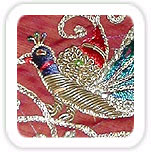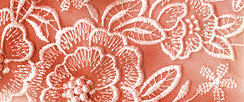
Zardozi the imperial metal embroidery, adorned the costumes of the
royalty, wall hanging, scabbards, walls of the regal tents and the rich
trappings of elephants and horses. Intricate patterns in gold and
silver, studded with pearls and precious stones enhanced the beauty of
rich and glowing silk, velvet and brocade.
History
Zardozi is an ancient Persian embroidery form (Zar in Persian means
gold and Dozi is embroidery) that has been passed down for generations.
It reached its peak under the patronage of Mughal Emperor Akbar. It saw
a decline during the reign of Aurangzeb as the royal patronage and favor
stopped and and the art was too expensive and the precious metals too
rare to carry on.
Zari and Zardozi work was revived after independence in Hydrabad and
Lucknow. The rarity of precious metal lead to the use of copper with
gold or silver polish or the silk thread. Now the embroidery style is
back in bloom. It is a must for any Indian wedding trousseau.
Process Stitches and Styles
Zari embroidery is done with a crochet hook using the metallic thread
and appears like chain stitch. Zardozi is an extension of the same. Zari
elements like coiled wire, dabka, tilla, beads etc are used to create
the motifs. Zardozi can alternatively be called metallic applique
embroidery.
The most prevalent zardozi elements segments of dabkaa, a tightly wound
spiral metal, Kora, a heavier and darker dabkaa a square sided dabkaa
that is wiry and erratic in appearance, sitaaras, round sequins, glass
and plastic beads and kasab, silver or gold-plated silver thread
The process involves tracing out the design on the cloth preferably
rich fabrics like silk, satin velvet etc. The fabric is stretched over
the wooden frame and the embroidery work begins. Each zardozi element is
picked up by the needle and incorporated appropriately into the pattern
by pushing the needle in the fabric.
The process of creating zari threads and zardozi elements was rather
complicated earlier. It needed a lot of patience and precision. Today
the modern means may have made the task a little easier but still the
adeptness and delicate handling remains the same.
Zardozi and zari garments have become very popular and make elegant
evening and ceremonial ware. The art is now being used for soft
furnishing products also.





